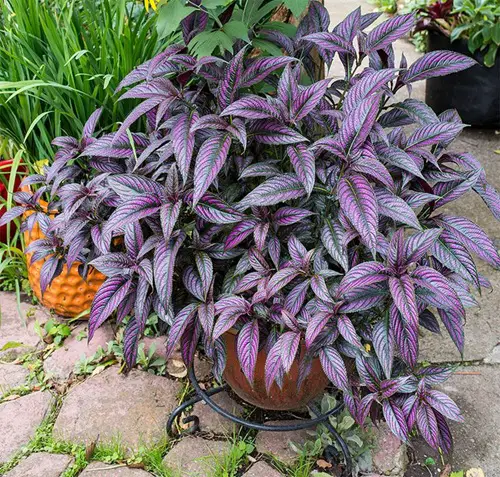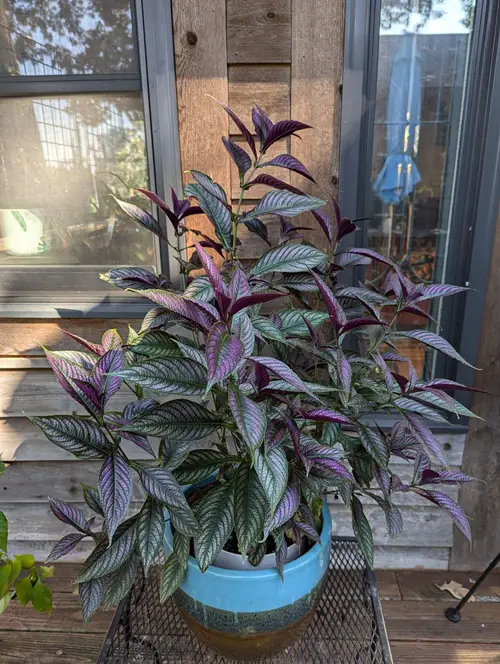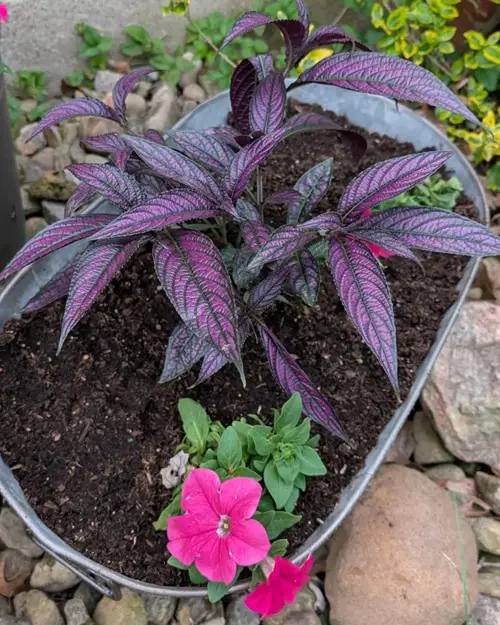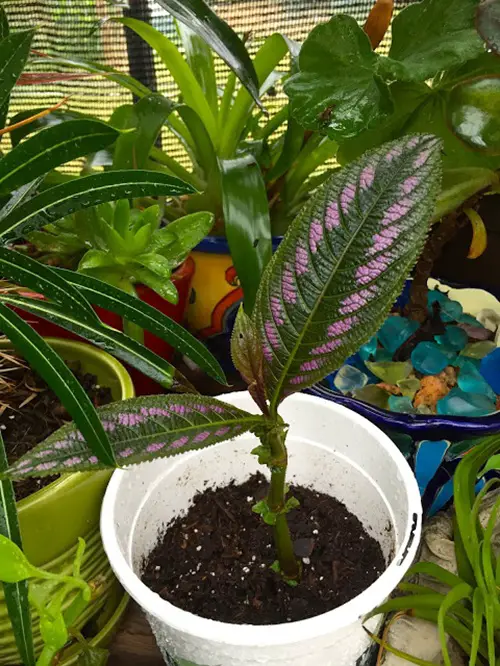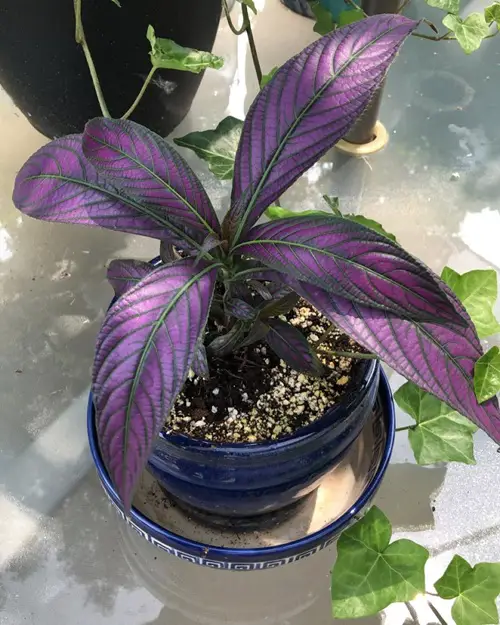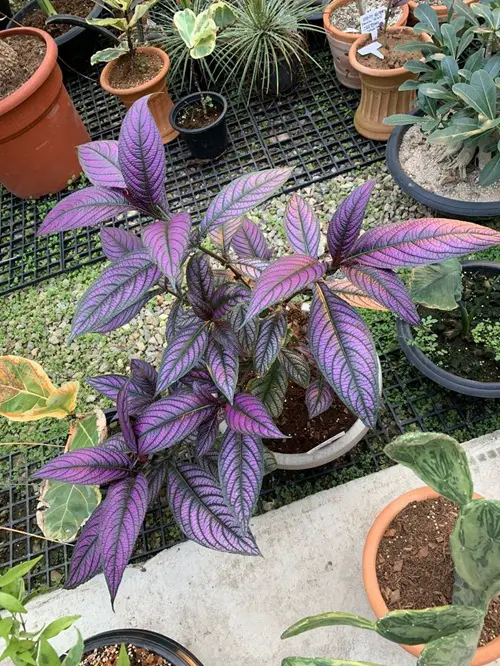This is how you can grow a bushier Persian Shield for that eye-catching display of purple hues in your home and garden.
With the tricks mentioned in this article, your Persian Shield will look like a lovely centerpiece rather than a slim plant with just a handful of purple leaves. These clever tricks will help you improve its health while focusing on making it bushier.
How to Grow Bushier Persian Shield
1. Pinch This Way
Everyone knows you should pinch Persian Shield to encourage bushiness, but the real secret is when? And how often? Pinching too early can stunt initial growth, and doing it too late will make it leggy. Well, the ideal time is when each stem has 4–6 sets of leaves, right before it tries to stretch.
You can use your fingers or sharp scissors to snip right above a node (the point where leaves grow out). This will force your plant to send out two new lateral shoots from that spot, multiplying its fullness. Repeat this every few weeks during active growth.
Pro Tip: After each pinch, lightly mist the plant with an Epsom salt solution or a seaweed extract spray to reduce shock and encourage faster recovery. Rotate the plant as well to ensure even light distribution, preventing uneven or one-sided growth.
2. Let It Be a Bit Thirsty
You can apply controlled water stress by letting the top 2–3 inches of soil dry out before watering again. This will stimulate root development, and strong roots will anchor fuller top growth. Remember, every time you water–water deeply!
Remember that this doesn’t mean neglect; instead, it means controlled withholding, just enough to nudge the plant into survival mode.
Once the plant senses a dry spell, it activates growth hormones and sends out more branches when you water it again. After this deliberate “drought,” give the plant a diluted dose of fish emulsion fertilizer once in a few days to kickstart a recovery phase with lush and bushy foliage.
And always check soil dryness with your finger or a moisture meter rather than relying on a schedule, as Persian Shield’s watering needs vary with humidity and pot size.
3. Cut From the Top
It is a bold move, but starting with a low cutback when your plant is about 10–12 inches tall can work wonders. This method, sometimes called a “hard prune,” will encourage the plant to branch from the base instead of only the middle. Cut the main stem to about 6 inches above a strong node.
Within two weeks, several new stems emerge from the tip and lower nodes. This will result in a denser, low-growing plant with more foliage layers. Don’t forget to support this regrowth with a high-nitrogen fertilizer to fuel the explosion of new stems.
Pro Tip: Time hard pruning for late spring or summer, when the plant is actively growing and can quickly recover. Avoid cutting in cold or dormant months.
4. Multiple Persian Shields in One Pot
How to grow a bushier Persian shield quickly? Plant multiple ones in the same pot. Unlike some plants that compete heavily when crowded, Persian Shield actually adapts well when paired with its own kind, as long as the pot is large enough.
You just have to choose a wide container (at least 10–12 inches across) with good drainage. Then plant two to three rooted cuttings or small nursery plants a few inches apart. This way, they don’t fight for nutrients too early, and their canopies can grow into each other without choking out the light or air circulation.
Pro Tip: Put one plant slightly off-center and the others around it. It will create a natural layering and give the illusion of a fuller plant without waiting months.
5. Limit Fertilizer in Early Growth
It may sound strange, but holding off on heavy feeding in the early weeks can promote a more compact and bushier plant. When your Persian Shield is fed too soon with high-nitrogen fertilizer, it races to grow tall and lanky rather than wide.
The best way is to feed lightly or stick to organic compost tea or worm casting liquid in the first 4–6 weeks. These provide gentle, balanced nutrition that encourages root and lateral shoot development, rather than rapid vertical growth.
Once your plant establishes a bushy shape, you can introduce a balanced or slightly nitrogen-rich feed to maintain the lush foliage. Always water the plant before applying fertilizer to prevent root burn and ensure nutrients are absorbed effectively.
6. Repot It In Snug Pot
You would think giving a plant more space would help it grow bigger, but that does not always work with Persian Shield. For bushier growth, you should keep it in a slightly snug pot, which can actually encourage more lateral shoots.
When roots sense limited space, they often direct energy into branching rather than stretching upward, and that is what you want. Choose a pot just 1–2 inches wider than the root ball. Avoid oversized containers that promote legginess.
Remember that good drainage is key, as waterlogged roots will do the opposite of what we want. Also, repotting in spring or early summer gives the plant the entire growing season to adjust and send out new branches.
With the right care and a few strategic tweaks, your Persian Shield can become a lush, bushy specimen in any space. Stay consistent with these methods, and you’ll have a fuller plant that’s both healthy and easy to maintain.


